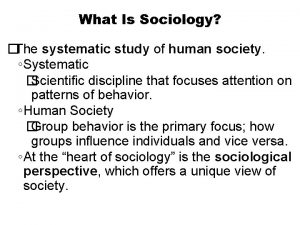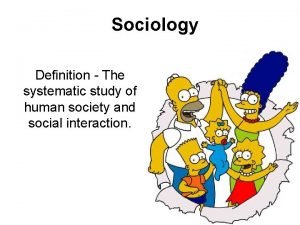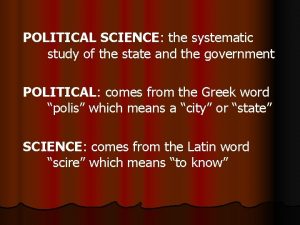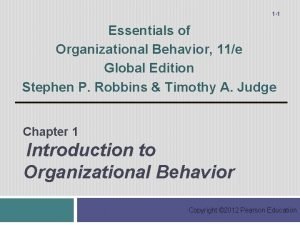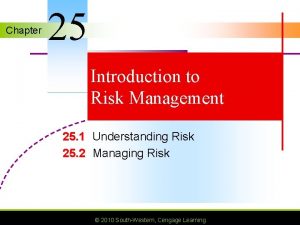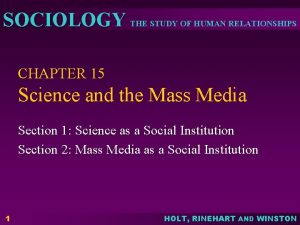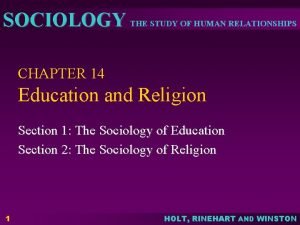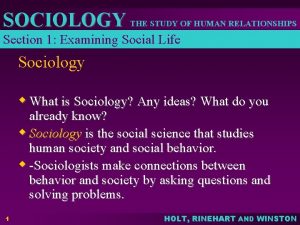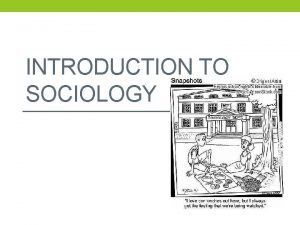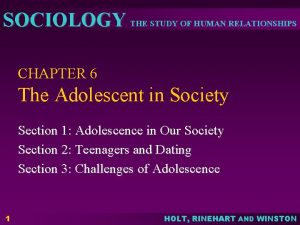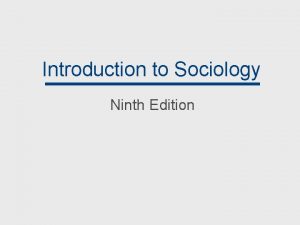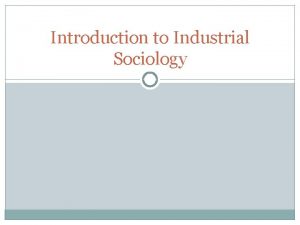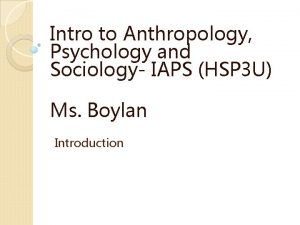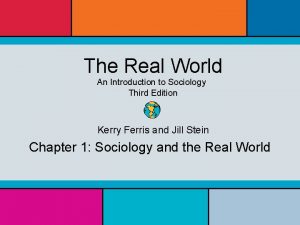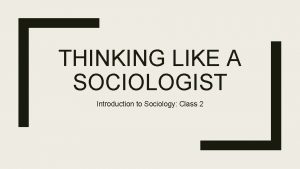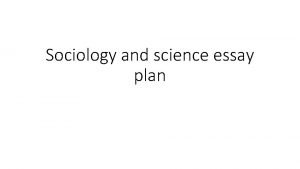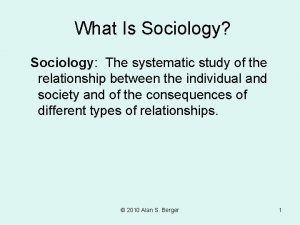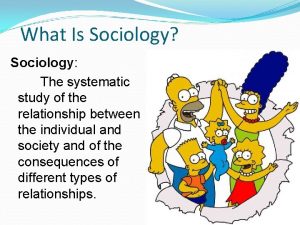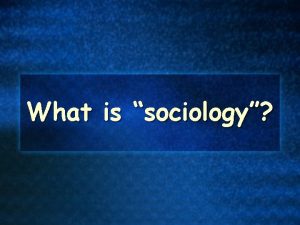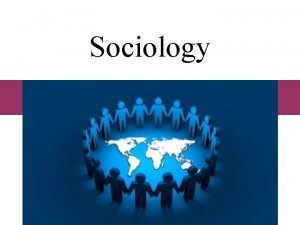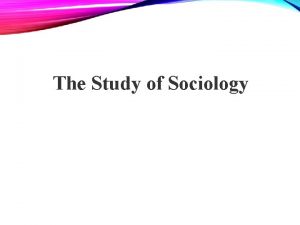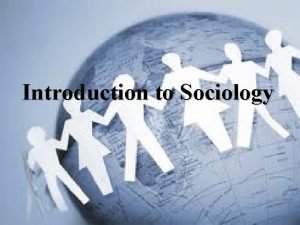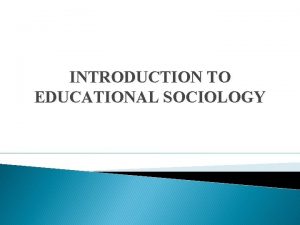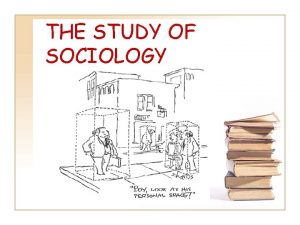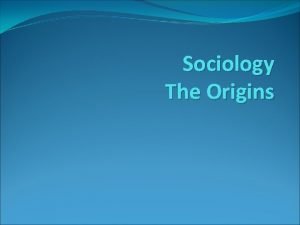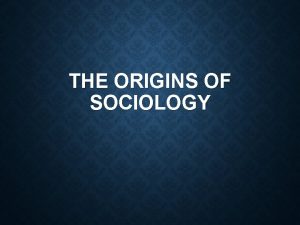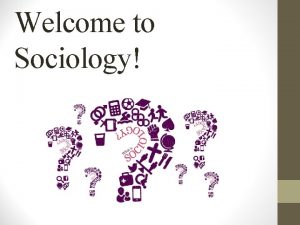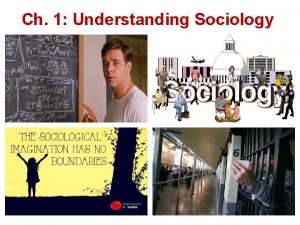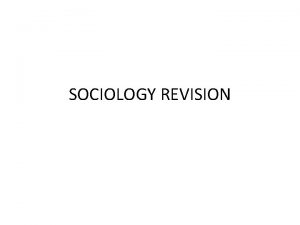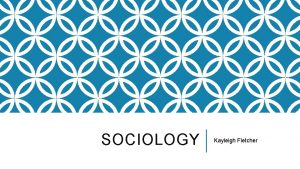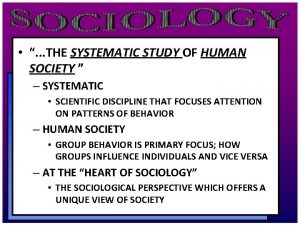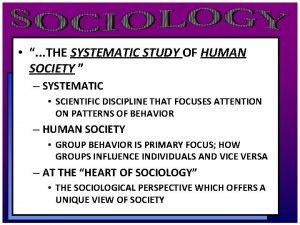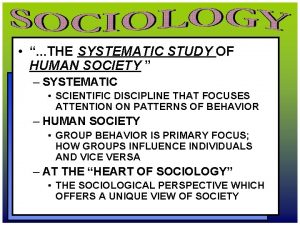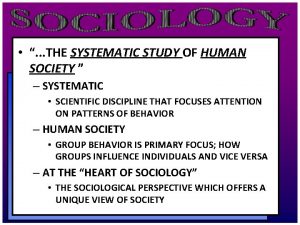Introduction to Sociology Sociology p the systematic study




















































- Slides: 52

Introduction to Sociology

Sociology p the systematic study of human society

Purpose of Sociology p C. Wright Mills n “the sociological imagination” p allows sociologists to place personal troubles of individuals within a framework of larger social issues § I. e. divorce

Sociological Perspective p seeing the general in the particular (Peter Berger, 1963) n Possible to identify general patterns in the behavior of particular people

p People are split into different categories n n p men vs. women rich vs. poor The categories to which we belong shape our experiences

Lillian Rubin (1976) Marriage Study Higher income women expect their men to be sensitive to others, to talk readily, and to share feelings p Lower income women look for men who do not drink to much, were not violent, and held steady jobs p

Seeing Strange in the Familiar p People do NOT decide what to do; society shapes our thoughts and deeds n Why do you choose a particular college? “I wanted to stay close to home” p “I got a basketball scholarship” p “My girlfriend goes to school here” p “I didn’t get into the school I wanted” p p Doesn’t really tell you how and why people go to college

Personal Choice p Emile Durkheim n Studied suicide figures in France and found: Protestants, wealthy, single, and men were more likely to commit suicide p Catholics, Jews, poor, and women were less likely to commit suicide p p Social Integration: categories of people with strong social ties vs. more individualistic

Living on the Margins p Outsiders- not part of the dominant group n the greater the social marginality, the better someone can use the sociological perspective n Need to be able to step back and observe

Crisis p Great Depression n people realized general forces were at work in their particular lives Not “Something is wrong with me; I can’t find a job” p Rather “The economy has collapsed; there are no jobs to be found” p

p If we can observe and learn about “the system” we can then make changes if necessary

Global Perspective

Global Perspective p The study of the larger world and our society’s place in it n n Our place in society shapes our life experiences The position of our society in the larger world system effects everyone in the U. S.

High-income Countries p p Nations with the highest overall standard of living Includes top 60 counties n U. S. , Canada, Argentina, Western Europe, South Africa, Israel n Produce most of the world’s goods and services Own most of the wealth n *These people are better off simply because they were born in these countries

Middle-income Countries Nations with a standard of living about average for the world as a whole p Includes 76 countries p n Eastern Europe, Africa, Latin America, Asia n Receive 6 -8 years of schooling Extreme social inequality (some very rich, some very poor) n

Low-income Countries p Nations with a low standard of living in which most people are poor p Most countries are located in Africa and a few in Asia Some very rich p Most lack safe housing, water, food, and little chance to improve their lives p

Comparisons to the U. S. • • Where we live shapes the lives we lead Societies throughout the world are increasingly interconnected Many social problems that we face in the U. S. are far more serious elsewhere Thinking globally helps us learn about ourselves

Applying the Sociological Perspective

Sociological Perspective p Seeing the general in the particular p Society shapes the lives of its members

Applying the Sociological Perspective p Why it is useful: n n n Sociology guides many of the laws and policies that shape our lives Making use of the sociological perspective leads to important personal growth and expanded awareness Good preparation for work

Sociology and Public Policy p Sociologists help shape public policy n p Racial desegregation, school busing laws, divorce Example n n Lenore Weitzman discovered women who leave marriages lose income Many states have passed laws that have increased women’s claim to martial property and enforced fathers’ job to support women raising their children

Benefits of Sociological Perspective 1. Helps us assess the truth of commonly held assumptions -Do we decide our own fate, if so we are likely to praise successful people as superior -pg. 10: Seeing Sociology in Everyday Life

2. Helps us assess both the opportunities and constraints in our lives -we play our cards but society deals us the hand -helps us “size up” the world to better accomplish our goals

3. Empowers us to be active participants in our society -if we do not understand how society operates, we are likely to accept the status quo -pg. 7: C. Wright Mills

4. Helps us live in a diverse world -U. S. represents 5% of the world’s population -95% live very differently -everyone sees their life as “right”, “natural”, and “better” -helps us think more critically about all ways of life

Origins of Sociology

Science and Sociology p French social thinker Auguste Comte (1798 -1857) first came up with the term sociology n Described a new way of looking at society n Wanted to find out how society could be improved and how society actually operates

Comte p Saw sociology as the product of a 3 -stage historical development 1. Theological- thinking guided by religion 2. Metaphysical- society as a natural, not supernatural system 3. Scientific- used a scientific approach to study sociology

Positivism p Definition: a way of understanding based on science n Society operates according to its laws p (much like the laws of nature)

Sociological Theory

Structural-Functional p Definition: n Framework for building theory that sees society as a complex system whose parts work together to promote solidarity and stability n Sociologists p Emile Durkheim, Auguste Comte, Herbert Spencer

p Points to Social Structure n any relatively stable pattern of social behavior n gives our lives shape (families, school, work, community)

p Examines Social Functions n the consequences of any social pattern for the operation of society as a whole n all social structures keep society going p similar to the way the human body operates

Robert K. Merton p Manifest Functions: n p recognized and intended consequences of any social pattern Latent Functions: n unrecognized and unintended consequences of any social pattern

p Social Dysfunction: n any social pattern that may disrupt the operation of society

Summary p Main goal is to figure out “what makes society tick” p critics say it ignores inequalities of social class, races, and gender

Social-Conflict Theory p Definition: n a framework for building theory that sees society as an arena of inequality that generates conflict and change

p investigate how social class, race, ethnicity, gender, sexual orientation, and age are linked to society’s unequal distribution of money, power, education, and social prestige p Focus on how social patterns benefit some while hurt others

p Can be used to bring about societal change that reduces inequality

Feminism and the Gender-Conflict Approach p Definition: n a point of view that focuses on inequality and conflict between women and men n closely linked to feminism p support of social equality for women and men

p Helps make us aware of the ways life places men in positions of power over women n at home, at work, in the media n also, shows importance of women to the development of society

Race-Conflict Approach p Definition: n point of view that focuses on inequality and conflict between people of different racial and ethnic categories

p Points out contributions made by people of color to the development of sociology

Review of Social-Conflict Approaches p Critics: n n n ignores shared values and interdependence cannot claim scientific objectivity paints society in broad strokes

Symbolic-Interaction Approach p Definition: n framework for building theory that sees society as the product of the everyday interactions of individuals n Max Weber p understand a setting from the point of view of the people in it

Society amounts to people interacting p Shows how individuals actually experience society p

Macro-level Orientation p Definition: n n n a broad focus on social structures that shape society as a whole Big picture Includes the structural-functional approach and the social-conflict approach

Micro-level Orientation p Definition: n n a close-up focus on social interactions in specific situations includes the symbolic-interaction approach

Applying the Approaches: The Sociology of Sports p The Functions of Sports n A structural-functional approach directs our attention to the ways in which sports help society operate n Sports have functional and dysfunctional consequences

Sports and Conflict p p Social-conflict analysis points out that games people play reflect their social standing. Sports have been oriented mostly toward males. Big league sports excluded people of color for decades. Sports in the United States are bound up with inequalities based on gender, race, and economic power.

Figure 1. 2 “Stacking” in Professional Football

Sports as Interaction p p Following the symbolic-interaction approach, sports are less a system than an ongoing process. All three theoretical approaches—structuralfunctional, social-conflict, and symbolicinteraction—provide different insights into sports. No one is more correct than the others.
 Systematic study in sociology
Systematic study in sociology Systematic study of human society
Systematic study of human society It is the systematic study of state and government
It is the systematic study of state and government Complementing intuition with systematic study
Complementing intuition with systematic study Chapter 25 introduction to risk management
Chapter 25 introduction to risk management Sociology the study of human relationships
Sociology the study of human relationships Sociology the study of human relationships answers
Sociology the study of human relationships answers Human relationships are examined by
Human relationships are examined by Herbert spencer introduction
Herbert spencer introduction Sociology the study of human relationships
Sociology the study of human relationships Sociology is the study of
Sociology is the study of Sociology is the study of
Sociology is the study of Introduction to sociology 9th edition
Introduction to sociology 9th edition Nature and scope of industrial sociology
Nature and scope of industrial sociology Anthropology psychology and sociology
Anthropology psychology and sociology The real world an introduction to sociology
The real world an introduction to sociology Venn diagram of anthropology sociology and psychology
Venn diagram of anthropology sociology and psychology Introduction to sociology
Introduction to sociology What is anthropology
What is anthropology Introduction to sociology essay
Introduction to sociology essay Introduction to sociology tischler
Introduction to sociology tischler Hát kết hợp bộ gõ cơ thể
Hát kết hợp bộ gõ cơ thể Slidetodoc
Slidetodoc Bổ thể
Bổ thể Tỉ lệ cơ thể trẻ em
Tỉ lệ cơ thể trẻ em Voi kéo gỗ như thế nào
Voi kéo gỗ như thế nào Tư thế worm breton là gì
Tư thế worm breton là gì Chúa yêu trần thế alleluia
Chúa yêu trần thế alleluia Các môn thể thao bắt đầu bằng tiếng chạy
Các môn thể thao bắt đầu bằng tiếng chạy Thế nào là hệ số cao nhất
Thế nào là hệ số cao nhất Các châu lục và đại dương trên thế giới
Các châu lục và đại dương trên thế giới Công thức tính độ biến thiên đông lượng
Công thức tính độ biến thiên đông lượng Trời xanh đây là của chúng ta thể thơ
Trời xanh đây là của chúng ta thể thơ Mật thư anh em như thể tay chân
Mật thư anh em như thể tay chân 101012 bằng
101012 bằng Phản ứng thế ankan
Phản ứng thế ankan Các châu lục và đại dương trên thế giới
Các châu lục và đại dương trên thế giới Thể thơ truyền thống
Thể thơ truyền thống Quá trình desamine hóa có thể tạo ra
Quá trình desamine hóa có thể tạo ra Một số thể thơ truyền thống
Một số thể thơ truyền thống Cái miệng nó xinh thế chỉ nói điều hay thôi
Cái miệng nó xinh thế chỉ nói điều hay thôi Vẽ hình chiếu vuông góc của vật thể sau
Vẽ hình chiếu vuông góc của vật thể sau Thế nào là sự mỏi cơ
Thế nào là sự mỏi cơ đặc điểm cơ thể của người tối cổ
đặc điểm cơ thể của người tối cổ Thế nào là giọng cùng tên? *
Thế nào là giọng cùng tên? * Vẽ hình chiếu đứng bằng cạnh của vật thể
Vẽ hình chiếu đứng bằng cạnh của vật thể Phối cảnh
Phối cảnh Thẻ vin
Thẻ vin đại từ thay thế
đại từ thay thế điện thế nghỉ
điện thế nghỉ Tư thế ngồi viết
Tư thế ngồi viết Diễn thế sinh thái là
Diễn thế sinh thái là Dạng đột biến một nhiễm là
Dạng đột biến một nhiễm là
